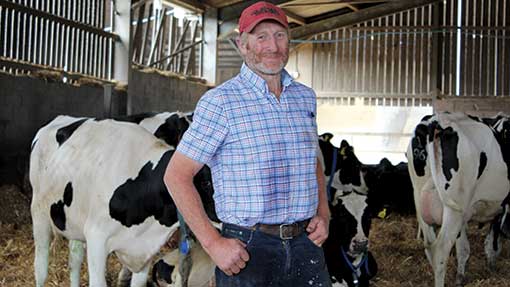Consider bought-in foot-trim labour for better cow health

Buying-in skilled labour to foot-trim cows three times a year is helping one 1,100 dairy cow unit to maintain foot health, reports Aly Balsom.
Whether it is labour or cow standing and lying budgets, time is a crucial factor in the fight to control lameness, but add in increasing cow numbers and it becomes even more important.
For herd manager Oliver Cromwell, herd expansion has resulted in a shift in where his time is needed, meaning he has less time to undertake preventative foot-trimming himself. As a result he has adopted a new foot-trimming programme, buying-in professional trimmers to trim the whole herd three times a year.
This strategy, along with a continued focus on improving cow comfort, has improved foot health dramatically. Currently, 94% of the herd is mobility score 0-1 (good and imperfect mobility), with just one cow score three (severely impaired mobility).
“When we had 700 cows I used to do all the preventive trimming at drying off and 100-150 days in-milk. But as cow numbers increased, it got a bit much,” explains Mr Cromwell who manages the 10,800 litre Holstein herd at Pancross Farm, Llancarfan.
Mr Cromwell says employing foot-trimmers has helped free up time to spend on fertility and dealing with fresh calvers and also helped fill a gap in highly skilled labour on farm. Now, foot-trimmer Steve Paul of cows feet.co.uk, and his team visit the farm every four months and undertake a whole farm trim that includes milkers, dry cows and in-calf heifers. The trimming team put together a full computer record of cow trims and treatments, along with a farm report.
See also: Read more for advice on good foot trimming
“They start at one end of the dairy and then within a week they’ve trimmed everything. We pay them per cow, but if they don’t need to trim they will put the foot down,” says Mr Cromwell, who mobility scores the herd monthly.
Mr Cromwell still trims any lame cows between preventive trims, but he has noticed he is seeing less severely lame cows. He believes this is due to the fact cows are being preventatively trimmed more regularly and because he doesn’t have the pressure of doing preventative trimming along with other jobs.
“The last thing you want is a lame cows as she will lose production and fertility and then before you know it she’s a cull.”
Oliver Cromwell, herd manager
“Prevention is key. The last thing you want is a lame cows as she will lose production and fertility and then before you know it she’s a cull. Plus it’s a welfare issue – you can’t do enough,” he says.
The farm has a zero tolerance to lameness with Mr Cromwell walking the cows daily and picking out any lame animals for treatment that day. Cow numbers will be entered into the herd management software so these animals are automatically drafted out at milking.
With the herd housed all year and milked three times a day, cow comfort also plays an important part in maximising foot health. To reduce pressure on feet, the aim is to keep the time cows are up and being milked to less than one hour. As a result the farm is modifying building design to maximise cow flow.
All the concrete throughout the farm is also grooved to reduce slipping and milking cows are housed on deep litter cubicles for cow comfort. Meanwhile fresh cows are kept in deep-bedded straw yards to take pressure off feet at this crucial time.
A specially designed 20ft concrete foot-bath has also been installed after the holding yard on exit from the parlour and cows are run through a 5% formalin bath at every milking. An antibiotic foot-bath may also be used following vet advice when necessary to get on top of digital dermatitis.
“In the past we used to have a plastic, single file foot-bath in the exit race just prior to the sorting gate. With this we used to get cows backing up and impeding cow flow,” says Mr Cromwell. “This wide bath means we have no issue with cow flow and it’s very easy to scrape out with the tractor.”
Mr Cromwell also believes ventilation impacts on cow lameness, particularly during hot weather. “I’ve heard that heat stress can cause cows to gather round troughs which means they are standing for longer so you know you’re going to get more ulcers,” he says.
To help avoid this and improve comfort in general, building fans have been installed and new buildings have been designed with ventilation in mind.
